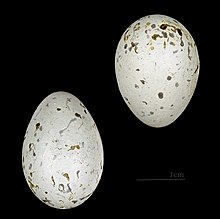Mask grouse
| Mask grouse | ||||||||||||
|---|---|---|---|---|---|---|---|---|---|---|---|---|

Mask grouse ( Eophona personata ) |
||||||||||||
| Systematics | ||||||||||||
|
||||||||||||
| Scientific name | ||||||||||||
| Eophona personata | ||||||||||||
| ( Temminck & Schlegel , 1845) |
The mask Grosbeak ( eophona personata ) is an East Asian bird art from the family of finches . A distinction is made between two subspecies for the mask bite.
features
The 23 cm long mask bite is yellow-brown to olive-green in color on the trunk. The head is black and is set off from the back plumage by a narrow gray neck band. The black wings have a blue wing spot and a white wing band. The black tail feathers have bruises. The head is dominated by a black face mask and a short, conical, yellow beak.
The song of the mask biter is soft, almost whispering. The calls are sometimes soft and quiet, sometimes sharp and high.
Occurrence
The masked grouse breeds in sparse forests and forest landscapes in southeast Siberia , northern China and Japan . He winters in central China and southern Japan. Its habitat are mountain forests.
behavior
The masked grouse lives in pairs during the breeding season and forms small groups in winter. It feeds on pine seeds, berries and, especially in the breeding season, on invertebrates.
The mask grouse builds a shallow shell nest from twigs in a tree. The nest is often built on branches far from the trunk. During the breeding season, the bird behaves territorially. The clutch consists of three to five eggs. The incubation period is eleven to twelve days. The young birds fledge after 13 days, but are looked after and fed by the male for another 14 days.
literature
- Horst Bielfeld : siskins, giraffe, bullfinches and grosbeak. Verlag Eugen Ulmer, Stuttgart 2003, ISBN 3-8001-3675-9 .
- Colin Harrison & Alan Greensmith: Birds. Dorling Kindersley Limited, London 1993, 2000, ISBN 3-831-00785-3
- Bryan Richard: Birds. Parragon, Bath, ISBN 1-405-45506-3
Web links
- Eophona personata in the endangered Red List species the IUCN 2008. Posted by: BirdLife International, 2008. Accessed January 31 of 2009.

